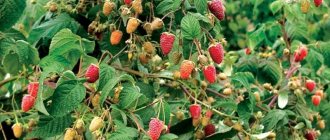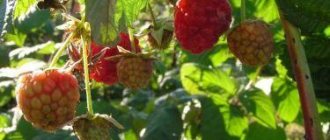Roseleaf raspberry is a beautiful garden plant with a rich vitamin composition of fruits, is not demanding in terms of growing conditions, develops well in different climatic environments, but often disappoints gardeners. What are the features of the variety and how not to fall for the tricks of marketers when purchasing - read further in the article.
Tibetan raspberry
To preserve the healing composition, it is better to dry the fruits of Tibetan raspberries for the winter.
in our country, the Tibetan raspberry bush is often grown not as a fruit tree, but as an ornamental one
Description of Tibetan raspberry
The plant belongs to the genus Rubus, family Rosaceae.
It is called differently in different sources:
- Rosolin;
- Roseleaf raspberry;
- Dwarf raspberry;
- Himalayan raspberry;
- Strawberry or Strawberry Raspberry;
- Tibetan raspberry;
- Norwegian;
- Miao Miao.
Varietal characteristics
Appearance of Roseleaf Raspberry:
- Bushes. The crown is round in shape. Wild shrubs can reach a height of up to 3 m. Garden plants - 0.4-1.0 m.
- Leaves. One petiole contains 5-7 leaves from light to dark green with yellow veins, corrugated, oblong-lanceolate, 3-8 cm long, with small denticles along the edges.
- Branches. Thin, flexible, woody at the roots, grassy at the top, covered with thorns. Fruit branches do not form clusters; flowers and fruits are evenly distributed throughout the bush.
- Spikes. They are densely located along the stems, curved and very sharp.
- Flowers . Raspberries bloom with single flowers from June-mid-July to mid-autumn. The flowers are large in size (up to 5 cm), with 5 petals.
- Berries. Large, up to 3-5 cm in size, coral-red or burgundy in color, juicy, easily separated from the stalk. On a bush they are located directed upwards. The taste is sweet and sour, the aroma resembles strawberry. Unripe fruits taste bland.
For Tibetan raspberries to develop their flavor, they need to be well ripened.
- Rhizome . Creeping, superficial. In a 3-year-old plant, it begins to intensively spread in breadth, occupying increasingly larger areas, and produces abundant growth.
Features of the variety
Although this plant belongs to the same genus as its common forest relative, the description of the Chinese raspberry may surprise many gardeners. Despite the close relationship with wild berries , there are many differences between them:
- Unlike wild raspberries, Tibetan raspberries bear fruit in separate berries, rather than forming clusters of them.
- The part of the plant located above the ground dies off every year and grows again in the spring. Thus, you can get fruits even from a bush in the first year of growth.
- The fruits may resemble strawberries in appearance, but are attached to the main plant in the same way as regular raspberries.
- The fruiting period is much longer. Almost immediately after growth begins, flowers begin to appear, and then fruits, and this process lasts a very long time - the last berries appear just before the first frost.
The fruits of strawberry Tibetan raspberries have an unusual taste - you can compare them with blackberries, to which a light note of pineapple has been added. This flavor combination is very rare.
An advantage of the culture is its frost resistance - almost any weather is suitable for it, it will survive in any conditions.
In addition, it does not require special care either. There is no need to carefully monitor its growth; you just need to water it on time, and it will continue to delight the gardener with flowers and berries. Despite the fact that it is very easy to grow, berries are almost never found on store shelves. This is due to the fact that it is difficult to transport it in its original form, and few people undertake this.
Due to the extensive and rapidly developing root system, it is very easy to maintain its growth, if this is the task that the gardener sets for himself. But stopping the indiscriminate spread is far from easy, and sometimes shrubs can fill all the available space, leaving no room for growing other crops.
Purpose
Tibetan raspberries are used for fruit consumption and in garden design.
Use of fruits
The fruits are processed and used:
- for making tasty and healthy jam;
- as a filling for pies;
- fresh berries are added to vegetable salads;
- as part of protein dishes with cottage cheese, yogurt, sour cream, nuts.
Do not eat raspberries with fish, eggs, mushrooms, or legumes, as this can disrupt the digestion process.
- as part of fruit salads along with apples, strawberries, plums, apricots, grapes, tangerines.
It is not recommended to eat raspberries with bananas. Since this can provoke poisoning due to fermentation processes.
- as an ingredient in compotes of apples, apricots, pears, peaches;
- dry the fruits and brew high-vitamin tea;
- eaten by grinding with sugar;
- frozen for the winter;
- Amateur winemakers prepare fragrant wine from it.
The taste of Tibetan raspberries is revealed after processing and has a strawberry-pineapple aroma.
Use in garden design
Bright green bushes with red berries and white flowers evenly scattered throughout them are of high value in garden design.
The bushes lend themselves well to shaping throughout the entire growth period.
With the help of a plant you can:
- hide unsightly areas;
- strengthen the slopes;
- use as a hedge that will prevent uninvited guests and animals from entering the site;
- create alpine slides;
- design rock gardens and decorative compositions.
Advantages and disadvantages, useful properties
The fruits have an unusual taste , reminiscent of blackberries with light notes of pineapple. This combination is rarely found in nature.
Appearance, long fruiting and flowering, which lasts from mid-summer until the end of September, make Tibetan raspberries an ideal addition to various landscape designs.
With its help you can build an alpine slide or make a hedge.
Easy to care for . This variety does not require special attention and constant monitoring. It is only necessary to water the bush on time so that it continues to delight with its appearance and tasty fruits.
It is poorly transported , so Tibetan raspberries are extremely rare on store shelves.
Creeping of the root system is more of a disadvantage than an advantage, because if the disorderly growth is not stopped in time, you will have to dig up the area, making room for other crops.
Sharp thorns can easily injure a person , so working with this variety can be dangerous and unpleasant.
Tibetan raspberries taste like blackberries with slight notes of pineapple.
Fruiting and productivity
The first harvest can be expected 3-4 years after planting the seedling:
- During the first year of growth, only stems and foliage will develop on the shrub;
- on the 2nd - you will be able to see several flowers and taste the first collected fruits;
- from the 3rd year it is already possible to harvest a more or less good harvest.
Roseleaf raspberries do not have high yields - up to 1 kg per bush per season.
The first ripened fruits appear in mid-July. The fruiting period ends with the first frost in October.
Characteristics of the variety
According to reviews from gardeners, Tibetan raspberries are worth planting on the site, if only for the sake of their beauty. Although its berries can be used in many different ways if desired. The viability of the plant is very high.
Drought resistance, frost resistance
Actively growing bushes are very demanding of moisture. The description of the strawberry raspberry variety states that the plant does not tolerate waterlogged soil, but needs regular watering. It is recommended to plant on a hill from which rainwater rolls off on its own.
During the winter, the above-ground part of the bush dies off and is cut off. The underground part tolerates frosts down to – 15 °C.
Productivity and fruiting
The ripening of the berries begins in July and lasts until October, until the leaves begin to fall. The yield per bush is low - up to 1 kg per season. Considering that the recommended planting density is 60 cm between bushes, from 1 m2 it will be possible to collect no more than 2 kg.
Considering the not very bright taste of Tibetan raspberries, its main purpose is decorative.
The berries are held very tightly on the shoots and are not prone to shedding. The berry can fall to the ground only after it has ripened to brown ripeness. But usually by this time it is collected by gardeners or pecked by birds.
Area of application of fruits
Dense rose-leaved raspberries travel very well. When picking the berries, the juice does not stain your hands. Keeps fresh in the refrigerator for up to 7 days. Can be used for making preserves, jams and compotes. In Asian countries, strawberry raspberries are added to homemade wine, dried and added to teas. In cooking, unsweetened berries are used in vegetable salads, and also stewed with beans, zucchini, mushrooms and meat. Culinary experts' reviews of Tibetan strawberry raspberries are the most positive.
Resistance to diseases and pests
Roseleaf strawberry raspberries have good resistance to diseases and pests. Aphids most actively attack shoots, and the same diseases that threaten ordinary raspberries can threaten them. Given the long period of fruiting, treatments against diseases and insects are carried out twice - in the spring before flowering, and also in the fall, after the leaves fall.
Advantages and disadvantages of the variety
An important advantage of the Tibetan raspberry is its ability to quickly conquer living space for itself. Having once planted a bush in a free place, in the future you will need to limit the growth so as not to drown out neighboring crops.
Excellent transportability of the strawberry raspberry harvest and a long period of flowering and fruiting distinguish the plant. Just look at the photo of the Tibetan raspberry to be convinced: with its very presence it decorates the area, lifting the mood.
Among the disadvantages, it is worth noting the low yield and extreme thorniness of the shoots.
Useful and harmful properties
Tibetan raspberries contain many useful substances (pectins, folic acid, copper, iron, potassium, vitamins E, C and P), which have a beneficial effect on the body:
- strengthens the cardiovascular system;
- raises hemoglobin;
- normalizes the functioning of the digestive system;
- improves metabolism;
- helps fight colds;
- has anti-aging properties;
- can be used as an antidepressant.
Roseleaf raspberries can be consumed by pregnant and lactating women.
There are no categorical prohibitions on use. People with:
- diabetes mellitus;
- prone to allergic reactions.
Advantages and disadvantages
The advantages of the variety include:
- long period of flowering and fruiting - you can eat fresh fruits for 2-3 months in a row;
- unusual taste is a plus for exotic lovers;
- unpretentiousness to growing conditions and care;
- raspberries are an excellent honey plant and attract bees;
- high decorative properties in landscape design;
- frost resistance and good tolerance to all weather conditions.
Of the minuses:
- poor transportability of fruits, so such raspberries are difficult to find on sale;
- poor shelf life (2-3 days in the refrigerator) – it is not possible to collect many fruits at one time for processing;
- increased creep of the root system - new shoots can appear at a distance of 1-2 m from the mother bush;
- very sharp and tenacious thorns.
Reviews from gardeners
Anna, 37 years old, Barnaul
This is the fourth year that I have been growing this “strawberry raspberry”. Complete disappointment. The seedlings were not cheap, but I bought a couple of bushes, seduced by the beautiful picture and description. They promised a new variety, a hybrid of raspberries and strawberries. Large-fruited, productive, remontant, with remarkably tasty fruits. There was little truth in this: indeed, it begins to bloom early and bears fruit until frost; The berries cannot be called small. I learned later that this is not a hybrid at all, but a separate wild species related to raspberries. But that’s not even the point: it’s a shame that its yield is low, the fruit’s taste is far from that of cultivated varieties, and there are many problems with cultivation. It's enough that the plants are terribly prickly. Even young leaves leave very unpleasant cuts on the skin. It is difficult to remove fruit-bearing branches and thin out bushes. In addition, the rhizomes spread greatly. When I planted it, I dug in some slate, like I would for regular raspberries, but it didn’t help. Extra shoots periodically appear even at a distance of a meter from the main bush. It turns out that this plant is not the best choice as a fruit plant, and I don’t need a thorny hedge (albeit a beautiful one). Most likely, I will get rid of this “new thing”. There is little benefit from it, it just takes up space in vain.
Nikolay, 48 years old, Leningrad region
I bought “Tibetskaya” as a new raspberry variety. The shrub is beautiful and winter-hardy, but this is where its advantages are limited. Fresh fruits have no taste or smell at all. If you wait for the berries to ripen on the bushes (they don’t ripen indoors, they just spoil), the taste turns out sweet, even cloying. The jam, including the “raw” one, has a very pleasant taste (at the same time strawberry, raspberry and even slightly pineapple), and the aroma of fresh strawberries. The problem is that you cannot collect berries for processing: there are few of them and the ripening period is greatly extended. To get a decent harvest, you need a lot of bushes. True, there are no difficulties with propagation: the rhizomes spread so aggressively that it is more difficult to clear the area of excess shoots than to collect planting material. Conclusion: the plant should appeal to exotic lovers who have large areas. He has nothing to do in ordinary gardens.
Valentina, 53 years old, Orel
A very special plant. The bushes are unusually elegant: bright green foliage, white flowers, scarlet berries sticking up. For landscape design - just the thing. Otherwise there are more problems than advantages. The rhizomes spread unusually actively: they clogged half of my plot in a year. It is difficult to process the bushes: the thorns leave deep scratches and tear clothes. There are few berries and they have no taste. True, I discovered one plus: my grandchildren are allergic, they cannot eat strawberries at all, and “Tibetan” berries do not cause unpleasant consequences (they say that they are truly hypoallergenic). If you mix them with sugar, they become tastier and even have a pleasant smell. So for now I’ll keep these bushes for the sake of my grandchildren. In general, as a fruit bush, this “raspberry” is no good. Most varieties of garden raspberries are much better in all respects.
Landing
Planting Roseleaf raspberries requires compliance with the following rules:
- Boarding time. The best planting time is considered to be the end of September-early October. A seedling planted during this period is most likely to take root and develop well.
- Selection of seedlings. The seedlings should look healthy. Choose those that have no damage, curled or yellowed leaves.
- Landing place. Depending on the region, raspberries can be planted both in the sun and in partial shade, but take into account the sun-loving nature of the plant.
Do not plant raspberries in places where water accumulates after rains and melting snow.
- Priming. The plant prefers fertile soils with a neutral or alkaline reaction.
- Disembarkation scheme. Plant raspberries in rows. Keep a distance of 80-120 cm between the bushes. The hole for the seedling should be up to 50 cm.
- Barring root growth. To prevent raspberries from spreading throughout the entire area, protect the growth of its roots by digging slate or other fencing into the ground to a depth of 1 m.
- Feeding. Add 1 bucket of peat and 0.5 buckets of manure humus to each planting hole.
- Watering the seedling. After planting, cover the seedling with soil and water generously with warm water.
Landing place
Strawberry raspberries absolutely do not tolerate waterlogging or waterlogging of the soil. Small hills and slopes with a slope of 15 degrees are ideal for it. When planting on a personal plot, it is recommended to choose well-lit places with fertile, loose soil. If there is a possibility of flooding or stagnation of water, it is better to create a drainage layer or grooves to drain water, and make the beds elevated (no more than 30 cm in height).
“Neighbors” do not play a specific role in the life of the strawberry raspberry. The strength of its growth is so great that it easily displaces weeds and cultivated plants (including even such malicious invaders as horseradish and horseradish).
Growing and care
Growing Tibetan raspberries does not cause much trouble and is not much different from growing other varieties of raspberries.
When working with raspberries, you should remember to protect yourself from thorns, which not only hurt, but also break off when pierced and remain in the skin.
Watering
After spring planting, raspberries need to be watered all summer, after autumn planting - 2-3 times, and then - depending on the weather.
Follow these watering guidelines:
- Daily. Water the Roseleaf Raspberry seedlings, as they do not tolerate the soil drying out. Each bush needs about 10 liters of water.
- During hot and dry periods. In addition to watering at the root, water by sprinkling.
With a lack of moisture, the berries become smaller and crumble.
- During the rainy season. Don't water the plants at all.
If there is an excess of moisture, raspberries can develop fungal diseases.
- Mature bush. Water during dry periods throughout the season.
After watering, loosen the soil. This must be done very carefully, preferably by hand, so as not to damage the surface root system. At the same time, weeds should be removed.
Trimming
In summer, pruning is carried out to thin out the bushes. Strong thickening does not allow light and heat to enter, disrupts the ventilation of the plant, which leads to the loss of color in the berries and leaves, they become small.
The following are subject to pruning:
- branches without ovaries;
- branches with damage;
- weak, poorly developing branches.
Feeding
Tibetan raspberries are not as demanding on fertilizing as high-yielding industrial varieties.
Fertilizing is applied 2 times a year:
- In the spring. To grow the bush and gain green mass in the root zone, add one fertilizer of your choice: mullein, saltpeter, wood ash, compost, potassium-phosphorus complex.
- In autumn. Use nitrogen fertilizer in late fall.
The effectiveness of fertilizers will be greater if, after application, the root zone is covered with mulch from manure, peat, and humus.
Reproduction
Roseleaf raspberry can be propagated in several ways:
- By shoots . Raspberries grow well from the roots. Near the mature bushes you can find many young shoots. Dig them out with a sharp shovel. The procedure can be carried out 2 times a year: in the fall - when the bushes are already dying;
- in the spring - until they entered the phase of intensive growth.
- select overripe berries, crush them and leave for 2-3 days;
Preparing for winter
A feature of Tibetan raspberries is the complete renewal of branches every year. Therefore, after the top part of the bush dies, cut it off completely, leaving stumps of about 4-5 cm.
Cover the cut plants with a 10-15 centimeter layer of humus, peat or straw.
Cover young, newly planted plants with agrofibre and mulch on top.
Features of cultivation, preparation for winter, an interesting way to protect the growth of roots, as well as what the bush and the Roseleaf raspberry berry itself look like, see in the video clip below:
Reproduction methods
Roseleaf raspberries have individual reproduction characteristics, so in order to get a harvest, you need to know how to plant Tibetan raspberries correctly and with what planting material.
Cuttings
The use of cuttings as planting material allows you to plant the required number of bushes. To obtain planting material, young shoots are taken and cut off at the top and bottom by 20-25 cm, the leaves are removed, except for the top two. The cuttings are immersed in a growth stimulator for a day. After which the planting material is planted in the soil and covered with film. After rooting, the planting material can be planted in open ground.
Rhizome shoots
The description of this method of propagating raspberries is the simplest and is often used by gardeners. For propagation, it is necessary to select a root shoot that is the most developed and located away from the mother shoot. Using a shovel, you need to dig up on four sides and carefully, without removing the soil, remove it from the soil and transplant it into the prepared hole.
Dividing adult bushes
This method is often used in the autumn. To plant, it is necessary to divide the adult bush into parts using a shovel in the area of the root neck. Each part is placed in a pre-fertilized hole and covered with earth. In order for the rose-leaved raspberry variety to quickly recover in a new place, it is necessary to choose a plant that is 5 years old for planting.
See also
How to propagate raspberries quickly at homeRead
Seeds
The Chinese hybrid rarely propagates by seeds. However, this method is possible and is most often used to breed a new variety, but not in garden plots, since the berry seeds require a special processing method and are very susceptible to diseases.
In order to independently prepare planting material in the form of seeds, you must:
- Collect berries that are ripe, but have no signs of rot or damage.
- Using a flat bowl, arrange the berries and crush them gently. Leave it like this for several days, with a piece of gauze on top of the abscess.
- Using a fine sieve, rinse the seeds with plenty of clean water.
- The remaining seeds must be spread on a cloth and dried.
- The seeds are placed in a container with sand and placed in a cool place. The vegetable compartment in the refrigerator is suitable.
After 2-3 days, containers with sand are placed on the windowsill, and within two to three weeks the first shoots appear. This method of growing crops is very labor-intensive and often ends in the death of the sprouts.
Pests and diseases
Tibetan raspberries are no different from other varieties in terms of susceptibility to diseases and pests. The most common of them:
- raspberry-strawberry weevil;
- raspberry beetle;
- anthracnose;
- yellow mosaic;
- root cancer;
- chlorosis.
If the disease cannot be avoided:
- remove and burn affected leaves and stems;
- treat the plants:
- insecticide (for pest damage);
- a solution of copper sulfate or Bordeaux mixture (for fungal diseases).
To prevent infection you should:
- apply fertilizing in a timely manner;
- remove weeds;
- avoid waterlogging of the soil;
- remove dry leaves and branches.
Video
For a more complete picture of the “Tibetan” raspberry, we offer you a short video presentation from an experienced gardener from Pskov:
Graduated from MGRI named after. Ordzhonikidze. My main specialty is a mining geophysicist, which means a person with an analytical mind and varied interests. I have my own house in the village (accordingly, I have experience in vegetable gardening, horticulture, mushroom growing, as well as fiddling with domestic animals and poultry). Freelancer, a perfectionist and a “borer” regarding his duties. Handmade lover, creator of exclusive jewelry made from stones and beads. A passionate admirer of the written word and a reverent observer of everything that lives and breathes.
How are buyers of this variety deceived?
Often, in order to profitably sell Tibetan raspberry seedlings, marketers resort to tricks and call them a hybrid of raspberries and strawberries, strawberries or blackberries, and greatly exaggerate the yield and taste.
At the same time, the names of the variety are often found: “Raspberry-strawberry”, “Zemmalina”, “Blackberry-raspberry hybrid”. The deception is facilitated by the external similarity of the berries and flowers, which in the photograph resemble strawberries.
Hybridization of raspberries and wild strawberries is impossible due to the biological incompatibility of the plants.
Advantages of application in landscape design
This variety of berry crop is popular among gardeners both in the Moscow region and other regions, since it can serve as an ornamental plant. Tibetan raspberries can grow quickly, so they are often used as a hedge when zoning a garden.
Roseleaf raspberry will look great if you plant ornamental shrubs and perennial flowers nearby, as its low growth allows you to admire the mosaic of foliage and flowers with fragrant fruits. It also combines beautifully in compositions with coniferous trees.
When designing flower beds and ridges, it is important to take into account that the bushes have sharp thorns and plant them where no one in the household can be injured.
Only if these conditions are met, Tibetan raspberries will delight you with delicious berries and decorate any local area with their beautiful appearance, as well as transform the most inconspicuous corner.
Advice from experienced gardeners
Some advice from gardeners on choosing planting material, caring for and growing Roseleaf raspberries:
- It is best to purchase seedlings from friends who have raspberries on their plot;
- the seeds of ordinary raspberries and Rozolistnaya are not very different from each other, but in Rozolistnaya they are smaller, so you can protect yourself from deception during the purchase;
- When buying seeds, first grow seedlings, and then transfer them to the site;
- You can trim dead branches not only in autumn, but also in early spring, when new shoots reach 10 cm;
- so that raspberries do not spread so intensively throughout the area, they should be planted in a shaded place;
- Buckets, basins, barrels and other containers can be used as fences for the root system, in which to plant raspberries and bury them in the ground.
Some gardeners recommend using spruce spruce branches as mulch, others categorically do not recommend doing this, since the needles contribute to soil oxidation.
Tips for preserving fruits:
- For long-term storage, it is best to dry the fruits;
- when preparing homemade preparations, combine raspberries with other berries and fruits, this will give the product a unique taste and aroma;
- Some gardeners recommend freezing raspberries and storing them in this form for up to a year, others do not recommend doing this, since the berry does not retain its shape.
In the following video, the gardener presented an unusual variety of Roseleaf raspberry for review:
Tibetan raspberry: planting and care in open ground
Tibetan raspberry: photo
If you decide to grow Tibetan raspberries on your plot, it is important to know that you need to purchase and plant Tibetan raspberry seedlings in early spring. This plant is undemanding to soil. But for their development, open sunny areas are required. It will not be able to get along where there is even a slight shadow.
Tibetan raspberry bushes grow very quickly and widely. And they litter the garden with a large number of shoots. Therefore, other plants planted close to the bushes will have a very difficult time surviving. The Seductive raspberry grows especially aggressively. For this reason, when planting Tibetan raspberries, it is recommended to dig trenches 50 centimeters deep around the entire perimeter. And insert slate or pieces of iron there. Tibetan raspberries need the same care as garden raspberry varieties.
Growing the Tibetan raspberry variety is quite simple.
And even a novice gardener can cope with this. The only thing to remember is that there are very sharp thorns. Because they are capable of causing serious wounds. Use protective gloves for pruning, weed removal, and fertilizing. And also harvesting. Tibetan raspberry: video about the variety
Where can I buy? Prices
You can buy Roseleaf raspberries in online stores that offer both seedlings and seeds.
The price ranges from:
- 390-550 rub. – for 1 seedling;
- about 28 rub. - 10 pieces. seeds
Be prepared to pay additionally for delivery of goods to your locality.
When buying a shrub, you should clearly understand that the berry is not a garden raspberry variety, much less a hybrid with non-standard taste.
Top dressing
It is optimal to fertilize in the spring (required) and autumn (optional, but desirable). Mullein is ideal in a ratio of 1:10 with the addition of complex fertilizer for fruit and berry crops.
You can immediately, after the snow melts, while the soil is still moist, add ammonium sulfate granules, and in the fall - potassium sulfide.
Granules without dilution with water are applied to the root zone and sprinkled with mulched peat, compost or rotted manure.
More on the topic: Remontant raspberries of the Cosmic variety
Similar varieties
A similar variety is the ornamental plant – Seductive raspberry (Rubus illecebrosus).
This is a small shrub. Reaching a height of 60 cm. There are hard thorns on the stems and thorns on the leaves. The berries are round in shape, scarlet, up to 3 cm in diameter with a sweetish taste, without much odor.
The decorative appeal lasts until late autumn. The plant is unpretentious in care and tolerates low temperatures well. Used in landscape design.
There is an opinion that Roseleaf raspberry and Seductive raspberry are two varieties of the same plant, differing in the size of the bush.
Bottom line
The raspberry hybrid has an attractive appearance and taste, and is not like the usual berry growing in every garden. The berries are large in size and have a bright red color. The crop is used as a decoration for the garden and landscape compositions, it retains the shape of the bush and attracts attention with its large berries and bright colors. The plant does not require special care and can bear fruit for a long time. When planting a hybrid Chinese raspberry, the gardener will receive a harvest throughout the summer.
Reviews of Roseleaf Raspberry
★★★★★
Larisa, 35 years old. The plant is very beautiful: the bushes are strewn with white flowers and with them red berries.
But the berries have neither taste nor aroma. In addition, raspberries spread intensively throughout the area, and for a dacha where every piece of land is used, this is not acceptable. Sharp thorns tear clothes and hurt painfully. I will completely breed this variety. ★★★★★
Nina, 41 years old. The bush took root well on the site, but then began to spread rapidly.
I had to completely dig up the plant and plant it in old buckets and basins. Thus, the indiscriminate spread stopped. I would call the berries edible, but they reveal their real flavor when cooked. However, my husband and children happily eat fresh fruits straight from the bushes. ★★★★★
Tatyana, 30 years old. The bush is very beautiful, but very prickly - you cannot touch it without gloves, which greatly complicates care and harvesting.
At the same time, the taste of the berries is simple and fresh. I don’t need a hedge, so I wouldn’t grow these raspberries if it weren’t for my allergic daughter. Roseleaf raspberries are a way out; a glass of berries contains a supply of vitamins for a month, which is very important for a child. Hide
Add your review
Roseleaf or Tibetan raspberry is a beautiful plant that is widely used in landscape design. The berries do not have high taste characteristics, but contain many useful substances. In order not to be disappointed when growing this variety, experienced gardeners recommend strictly limiting root growth and consuming processed fruits.
0
0
Copy link
Tibetan raspberry: description of the variety and features
Tibetan raspberry: photo of the bush
Tibetan raspberries produce low yields, allowing you to collect about one kilogram of berries from one bush. Has average resistance to frost. The bushes are completely covered with sharp needles. Shoots form quite aggressively. Refers to varieties of medium ripening. Fruits take a long time to form. The leaves are small in size. They have some roughness on the surface. The edges are like small teeth.
Raspberry fruits of the Tibetan variety weigh 5 grams and have a diameter of about 30 mm. They have a round or conical shape. And they can be painted in rich red shades or scarlet. They have a rather mediocre taste. And also a slightly perceptible smell.
Tibetan raspberries are highly resistant to various diseases and harmful insects. Bushes are propagated by layering, cuttings or by dividing the bush. The Tibetskaya raspberry variety is not registered with the Federal State Budgetary Institution State Variety Commission.











